Intellectual Property Law: UK, EU Patents and Trademarks Analysis
VerifiedAdded on 2019/09/23
|8
|2879
|205
Report
AI Summary
This report provides a comprehensive overview of Intellectual Property Law, focusing on the legal frameworks in the UK and the European Union. It begins by defining intellectual property and its importance in protecting creative works and promoting economic growth, including copyrights, patents, industrial designs, and trademarks. The report then details the UK Intellectual Property Act of 2014, outlining the criteria for owning intellectual property and the historical context of its development. It further examines the UK Patent Act of 1977, explaining patentable inventions, novelty requirements, and the role of the European Patent Convention (EPC), including its guidelines for patentable inventions. The report also explores the advantages of the Patent Cooperation Treaty (PCT) for international patent protection. Furthermore, it discusses patent protection in the European Union, the actions of the European Commission, including the unitary patent and Unified Patent Court, and other mechanisms such as utility models and Supplementary Protection Certificates (SPCs). The report also covers the UK Trademark Act of 1994, defining trademarks and outlining the grounds for refusal of registration. Finally, it highlights the recent EU trademark reform legislation, aiming to streamline and improve trademark registration systems within the EU. This report is a valuable resource for students seeking to understand the complexities of intellectual property law and its application in the UK and EU.

INTELLECTUAL PROPERTY LAW
The intellectual property law is the area of law that concerns with the rules and provisions for
securing the legal rights to inventions, designs and artistic works. Just as there are laws available
for protecting our personal properties and real estate, the intellectual property law helps the
individuals in controlling their intangible assets1. Under these laws, the owners or creators of
works are provided with certain rights. The most common intellectual property rights include
copyrights, patents, industrial designs, trademarks so on and so forth.
The UK Intellectual Property Rights Act
The UK Intellectual Property Act, 20142 defines intellectual property as something unique that
any person physically creates. It includes anything from original plays, to inventions and
company logos. The main purpose of intellectual property law is to safeguard peoples’ interests
in creating new technologies, artistic expressions as well as promoting economic growth. Which
is why, when individuals are ensured that their creative works are well protected, then they will
be encouraged to continue creating things. So, it will help in creating jobs, developing new
technology, making the society progressive and bringing about changes around us. IPR includes
the following terms:
i. Names of products or brands
ii. Inventions
iii. Design and look of the products
iv. Writings, music, films and other artistic works
The law further elaborates that an individual can own an intellectual property if:
He/she created it and fulfill the requirements of copyrights, patents, designs etc.
He/she has purchased the work from the original creator or a previous user.
He/she has also sought the permission to use it from its originator.
He/she possess a brand that could be a trademark such as a well-known product name.
The UK government in the past had drawn constitutional conventions from numerous sources
and found the basis for protecting personal rights in general and intellectual property rights in
particular. The intellectual property law came into existence even in the era of royal
delinquencies. In those days the royal charters or stamps were used for granting the monopoly to
produce goods. However, certain novelties misused those powers and the parliament viewed that
such royal fervors would be detrimental for free trade. With this observation, the development of
intellectual property law in practical terms took place with a purpose of protecting public
welfare. Later the intellectual property was regulated under common law. In 1623, the Statute of
Monopolies was enacted that termed all the monopolies illegal. The early copyright privileges,
prior to the licensing regime, were granted as monopolies in the form of letters patent. So, we
1 'What Are Intellectual Property Rights?' (The British Library)
<https://www.bl.uk/business-and-ip-centre/articles/what-are-intellectual-property-rights> accessed 18 October
2016.
2 'Intellectual Property Act 2014' (Legislation.gov.uk)
<http://www.legislation.gov.uk/ukpga/2014/18/contents/enacted> accessed 17 October 2016.
The intellectual property law is the area of law that concerns with the rules and provisions for
securing the legal rights to inventions, designs and artistic works. Just as there are laws available
for protecting our personal properties and real estate, the intellectual property law helps the
individuals in controlling their intangible assets1. Under these laws, the owners or creators of
works are provided with certain rights. The most common intellectual property rights include
copyrights, patents, industrial designs, trademarks so on and so forth.
The UK Intellectual Property Rights Act
The UK Intellectual Property Act, 20142 defines intellectual property as something unique that
any person physically creates. It includes anything from original plays, to inventions and
company logos. The main purpose of intellectual property law is to safeguard peoples’ interests
in creating new technologies, artistic expressions as well as promoting economic growth. Which
is why, when individuals are ensured that their creative works are well protected, then they will
be encouraged to continue creating things. So, it will help in creating jobs, developing new
technology, making the society progressive and bringing about changes around us. IPR includes
the following terms:
i. Names of products or brands
ii. Inventions
iii. Design and look of the products
iv. Writings, music, films and other artistic works
The law further elaborates that an individual can own an intellectual property if:
He/she created it and fulfill the requirements of copyrights, patents, designs etc.
He/she has purchased the work from the original creator or a previous user.
He/she has also sought the permission to use it from its originator.
He/she possess a brand that could be a trademark such as a well-known product name.
The UK government in the past had drawn constitutional conventions from numerous sources
and found the basis for protecting personal rights in general and intellectual property rights in
particular. The intellectual property law came into existence even in the era of royal
delinquencies. In those days the royal charters or stamps were used for granting the monopoly to
produce goods. However, certain novelties misused those powers and the parliament viewed that
such royal fervors would be detrimental for free trade. With this observation, the development of
intellectual property law in practical terms took place with a purpose of protecting public
welfare. Later the intellectual property was regulated under common law. In 1623, the Statute of
Monopolies was enacted that termed all the monopolies illegal. The early copyright privileges,
prior to the licensing regime, were granted as monopolies in the form of letters patent. So, we
1 'What Are Intellectual Property Rights?' (The British Library)
<https://www.bl.uk/business-and-ip-centre/articles/what-are-intellectual-property-rights> accessed 18 October
2016.
2 'Intellectual Property Act 2014' (Legislation.gov.uk)
<http://www.legislation.gov.uk/ukpga/2014/18/contents/enacted> accessed 17 October 2016.
Paraphrase This Document
Need a fresh take? Get an instant paraphrase of this document with our AI Paraphraser
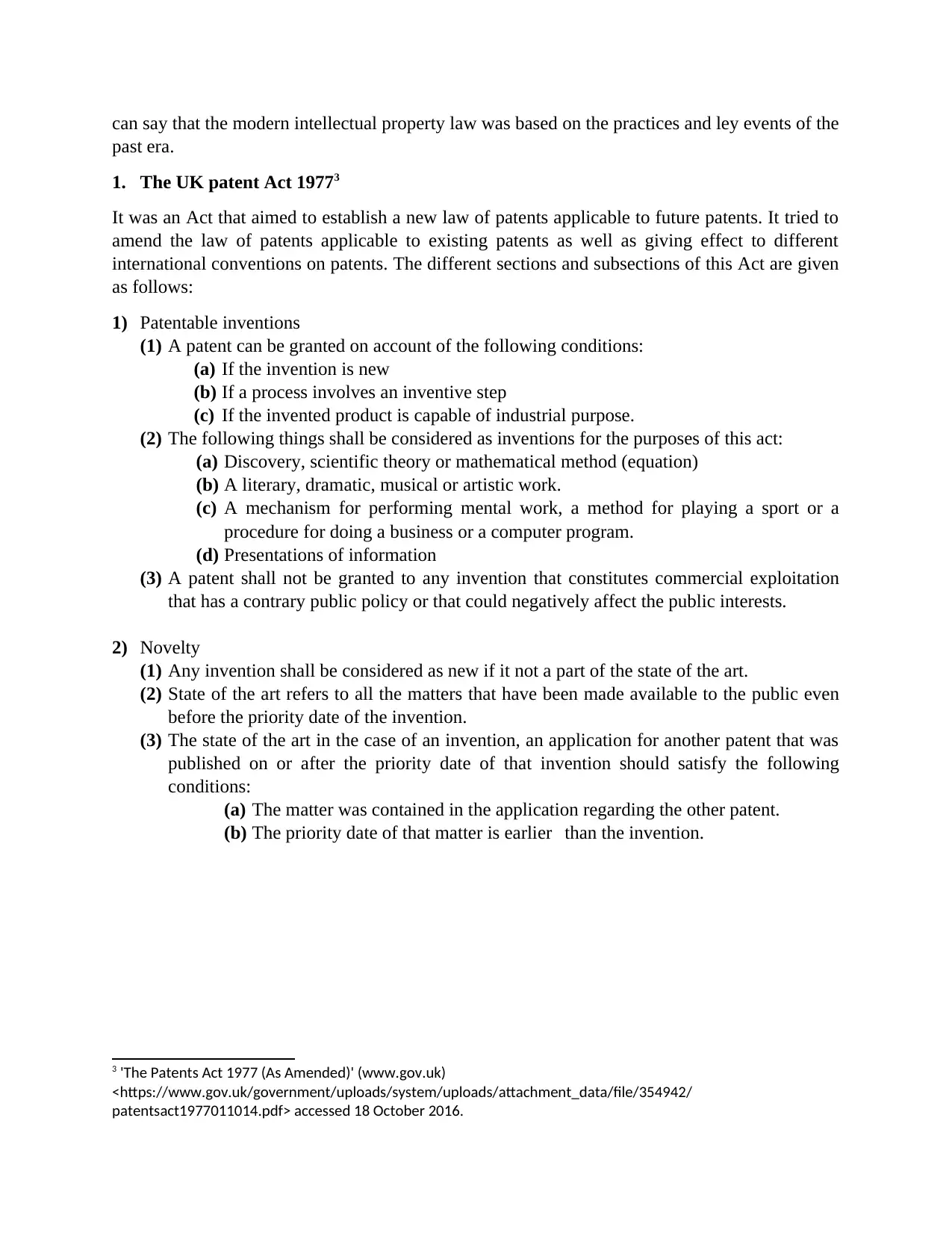
can say that the modern intellectual property law was based on the practices and ley events of the
past era.
1. The UK patent Act 19773
It was an Act that aimed to establish a new law of patents applicable to future patents. It tried to
amend the law of patents applicable to existing patents as well as giving effect to different
international conventions on patents. The different sections and subsections of this Act are given
as follows:
1) Patentable inventions
(1) A patent can be granted on account of the following conditions:
(a) If the invention is new
(b) If a process involves an inventive step
(c) If the invented product is capable of industrial purpose.
(2) The following things shall be considered as inventions for the purposes of this act:
(a) Discovery, scientific theory or mathematical method (equation)
(b) A literary, dramatic, musical or artistic work.
(c) A mechanism for performing mental work, a method for playing a sport or a
procedure for doing a business or a computer program.
(d) Presentations of information
(3) A patent shall not be granted to any invention that constitutes commercial exploitation
that has a contrary public policy or that could negatively affect the public interests.
2) Novelty
(1) Any invention shall be considered as new if it not a part of the state of the art.
(2) State of the art refers to all the matters that have been made available to the public even
before the priority date of the invention.
(3) The state of the art in the case of an invention, an application for another patent that was
published on or after the priority date of that invention should satisfy the following
conditions:
(a) The matter was contained in the application regarding the other patent.
(b) The priority date of that matter is earlier than the invention.
3 'The Patents Act 1977 (As Amended)' (www.gov.uk)
<https://www.gov.uk/government/uploads/system/uploads/attachment_data/file/354942/
patentsact1977011014.pdf> accessed 18 October 2016.
past era.
1. The UK patent Act 19773
It was an Act that aimed to establish a new law of patents applicable to future patents. It tried to
amend the law of patents applicable to existing patents as well as giving effect to different
international conventions on patents. The different sections and subsections of this Act are given
as follows:
1) Patentable inventions
(1) A patent can be granted on account of the following conditions:
(a) If the invention is new
(b) If a process involves an inventive step
(c) If the invented product is capable of industrial purpose.
(2) The following things shall be considered as inventions for the purposes of this act:
(a) Discovery, scientific theory or mathematical method (equation)
(b) A literary, dramatic, musical or artistic work.
(c) A mechanism for performing mental work, a method for playing a sport or a
procedure for doing a business or a computer program.
(d) Presentations of information
(3) A patent shall not be granted to any invention that constitutes commercial exploitation
that has a contrary public policy or that could negatively affect the public interests.
2) Novelty
(1) Any invention shall be considered as new if it not a part of the state of the art.
(2) State of the art refers to all the matters that have been made available to the public even
before the priority date of the invention.
(3) The state of the art in the case of an invention, an application for another patent that was
published on or after the priority date of that invention should satisfy the following
conditions:
(a) The matter was contained in the application regarding the other patent.
(b) The priority date of that matter is earlier than the invention.
3 'The Patents Act 1977 (As Amended)' (www.gov.uk)
<https://www.gov.uk/government/uploads/system/uploads/attachment_data/file/354942/
patentsact1977011014.pdf> accessed 18 October 2016.
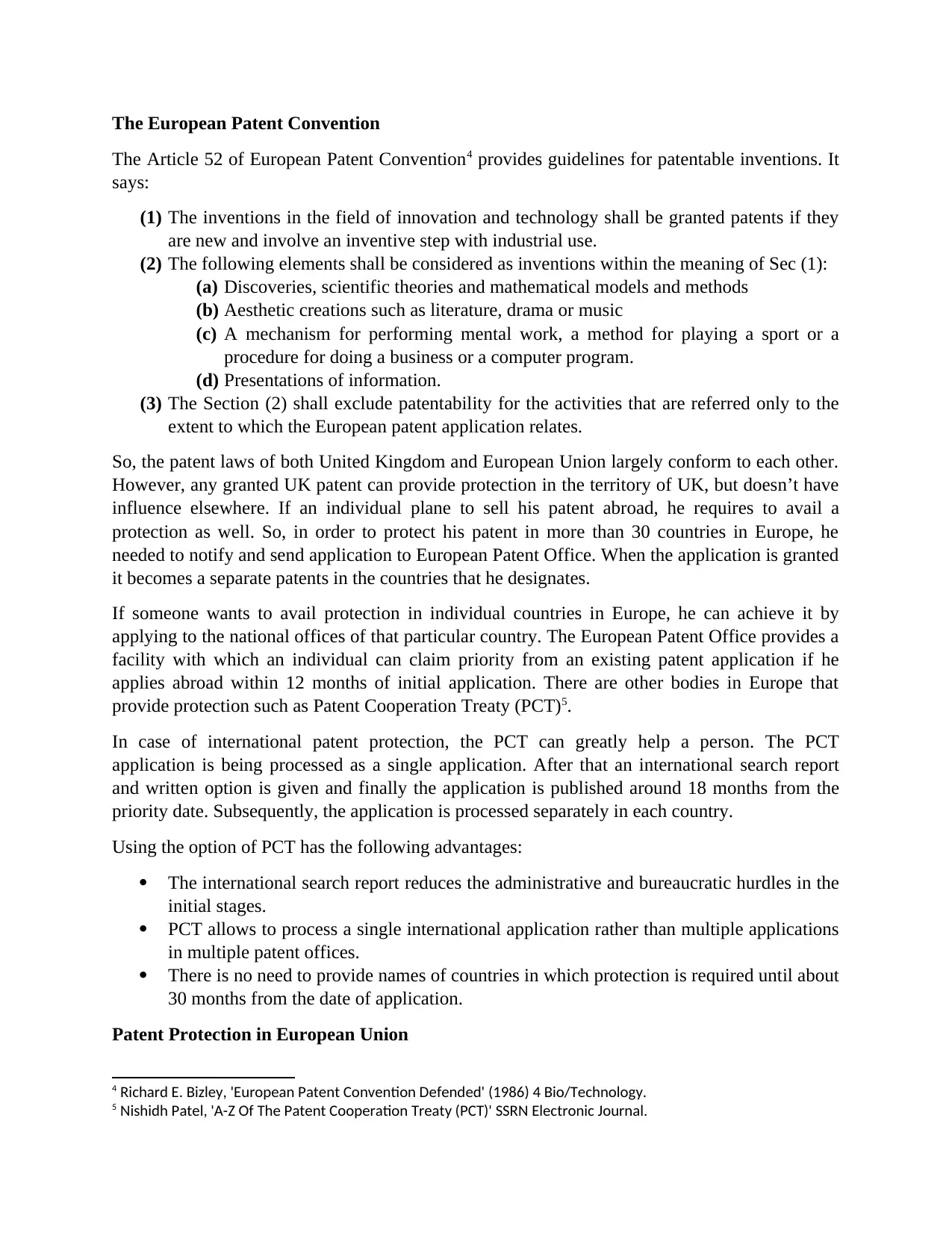
The European Patent Convention
The Article 52 of European Patent Convention4 provides guidelines for patentable inventions. It
says:
(1) The inventions in the field of innovation and technology shall be granted patents if they
are new and involve an inventive step with industrial use.
(2) The following elements shall be considered as inventions within the meaning of Sec (1):
(a) Discoveries, scientific theories and mathematical models and methods
(b) Aesthetic creations such as literature, drama or music
(c) A mechanism for performing mental work, a method for playing a sport or a
procedure for doing a business or a computer program.
(d) Presentations of information.
(3) The Section (2) shall exclude patentability for the activities that are referred only to the
extent to which the European patent application relates.
So, the patent laws of both United Kingdom and European Union largely conform to each other.
However, any granted UK patent can provide protection in the territory of UK, but doesn’t have
influence elsewhere. If an individual plane to sell his patent abroad, he requires to avail a
protection as well. So, in order to protect his patent in more than 30 countries in Europe, he
needed to notify and send application to European Patent Office. When the application is granted
it becomes a separate patents in the countries that he designates.
If someone wants to avail protection in individual countries in Europe, he can achieve it by
applying to the national offices of that particular country. The European Patent Office provides a
facility with which an individual can claim priority from an existing patent application if he
applies abroad within 12 months of initial application. There are other bodies in Europe that
provide protection such as Patent Cooperation Treaty (PCT)5.
In case of international patent protection, the PCT can greatly help a person. The PCT
application is being processed as a single application. After that an international search report
and written option is given and finally the application is published around 18 months from the
priority date. Subsequently, the application is processed separately in each country.
Using the option of PCT has the following advantages:
The international search report reduces the administrative and bureaucratic hurdles in the
initial stages.
PCT allows to process a single international application rather than multiple applications
in multiple patent offices.
There is no need to provide names of countries in which protection is required until about
30 months from the date of application.
Patent Protection in European Union
4 Richard E. Bizley, 'European Patent Convention Defended' (1986) 4 Bio/Technology.
5 Nishidh Patel, 'A-Z Of The Patent Cooperation Treaty (PCT)' SSRN Electronic Journal.
The Article 52 of European Patent Convention4 provides guidelines for patentable inventions. It
says:
(1) The inventions in the field of innovation and technology shall be granted patents if they
are new and involve an inventive step with industrial use.
(2) The following elements shall be considered as inventions within the meaning of Sec (1):
(a) Discoveries, scientific theories and mathematical models and methods
(b) Aesthetic creations such as literature, drama or music
(c) A mechanism for performing mental work, a method for playing a sport or a
procedure for doing a business or a computer program.
(d) Presentations of information.
(3) The Section (2) shall exclude patentability for the activities that are referred only to the
extent to which the European patent application relates.
So, the patent laws of both United Kingdom and European Union largely conform to each other.
However, any granted UK patent can provide protection in the territory of UK, but doesn’t have
influence elsewhere. If an individual plane to sell his patent abroad, he requires to avail a
protection as well. So, in order to protect his patent in more than 30 countries in Europe, he
needed to notify and send application to European Patent Office. When the application is granted
it becomes a separate patents in the countries that he designates.
If someone wants to avail protection in individual countries in Europe, he can achieve it by
applying to the national offices of that particular country. The European Patent Office provides a
facility with which an individual can claim priority from an existing patent application if he
applies abroad within 12 months of initial application. There are other bodies in Europe that
provide protection such as Patent Cooperation Treaty (PCT)5.
In case of international patent protection, the PCT can greatly help a person. The PCT
application is being processed as a single application. After that an international search report
and written option is given and finally the application is published around 18 months from the
priority date. Subsequently, the application is processed separately in each country.
Using the option of PCT has the following advantages:
The international search report reduces the administrative and bureaucratic hurdles in the
initial stages.
PCT allows to process a single international application rather than multiple applications
in multiple patent offices.
There is no need to provide names of countries in which protection is required until about
30 months from the date of application.
Patent Protection in European Union
4 Richard E. Bizley, 'European Patent Convention Defended' (1986) 4 Bio/Technology.
5 Nishidh Patel, 'A-Z Of The Patent Cooperation Treaty (PCT)' SSRN Electronic Journal.
⊘ This is a preview!⊘
Do you want full access?
Subscribe today to unlock all pages.

Trusted by 1+ million students worldwide
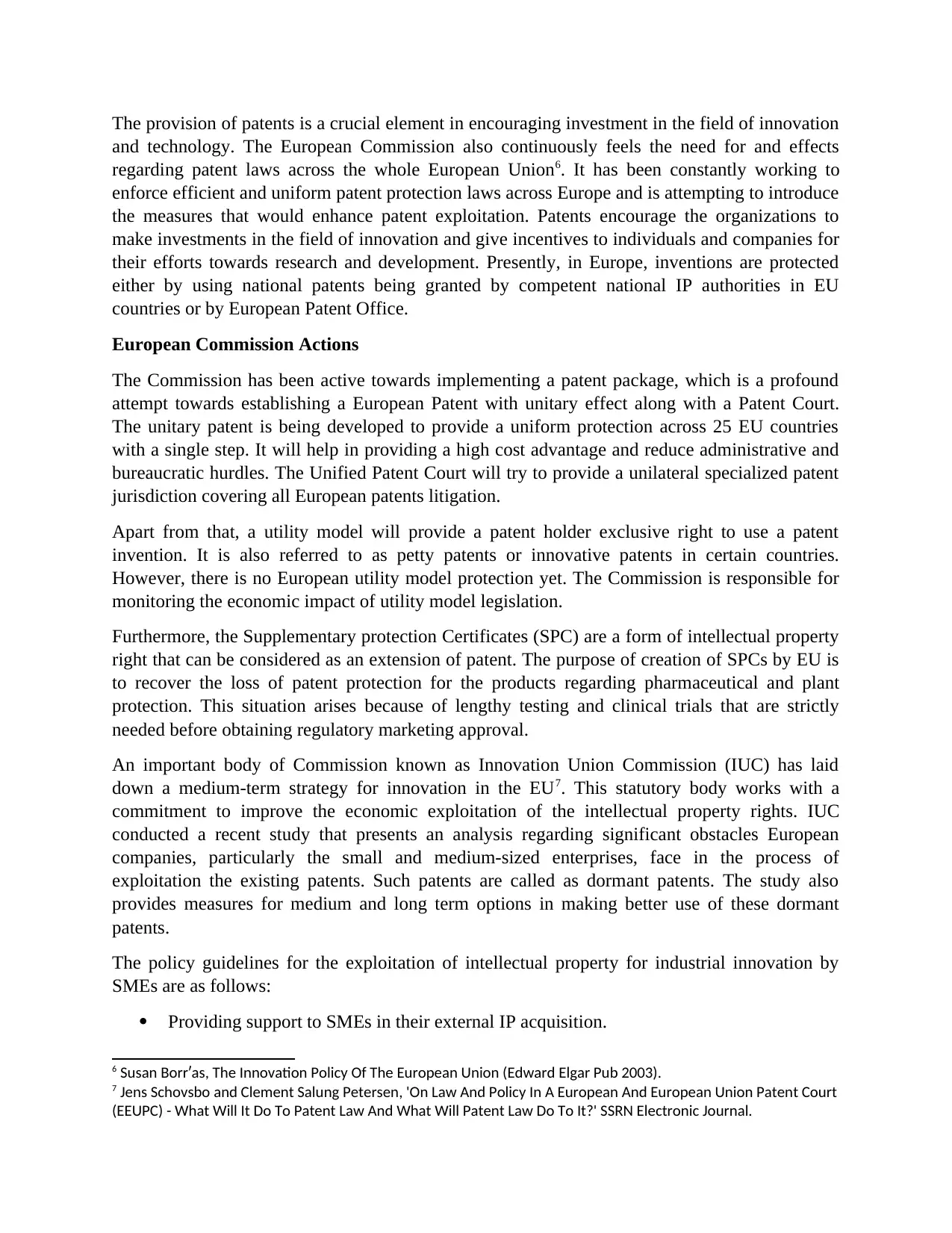
The provision of patents is a crucial element in encouraging investment in the field of innovation
and technology. The European Commission also continuously feels the need for and effects
regarding patent laws across the whole European Union6. It has been constantly working to
enforce efficient and uniform patent protection laws across Europe and is attempting to introduce
the measures that would enhance patent exploitation. Patents encourage the organizations to
make investments in the field of innovation and give incentives to individuals and companies for
their efforts towards research and development. Presently, in Europe, inventions are protected
either by using national patents being granted by competent national IP authorities in EU
countries or by European Patent Office.
European Commission Actions
The Commission has been active towards implementing a patent package, which is a profound
attempt towards establishing a European Patent with unitary effect along with a Patent Court.
The unitary patent is being developed to provide a uniform protection across 25 EU countries
with a single step. It will help in providing a high cost advantage and reduce administrative and
bureaucratic hurdles. The Unified Patent Court will try to provide a unilateral specialized patent
jurisdiction covering all European patents litigation.
Apart from that, a utility model will provide a patent holder exclusive right to use a patent
invention. It is also referred to as petty patents or innovative patents in certain countries.
However, there is no European utility model protection yet. The Commission is responsible for
monitoring the economic impact of utility model legislation.
Furthermore, the Supplementary protection Certificates (SPC) are a form of intellectual property
right that can be considered as an extension of patent. The purpose of creation of SPCs by EU is
to recover the loss of patent protection for the products regarding pharmaceutical and plant
protection. This situation arises because of lengthy testing and clinical trials that are strictly
needed before obtaining regulatory marketing approval.
An important body of Commission known as Innovation Union Commission (IUC) has laid
down a medium-term strategy for innovation in the EU7. This statutory body works with a
commitment to improve the economic exploitation of the intellectual property rights. IUC
conducted a recent study that presents an analysis regarding significant obstacles European
companies, particularly the small and medium-sized enterprises, face in the process of
exploitation the existing patents. Such patents are called as dormant patents. The study also
provides measures for medium and long term options in making better use of these dormant
patents.
The policy guidelines for the exploitation of intellectual property for industrial innovation by
SMEs are as follows:
Providing support to SMEs in their external IP acquisition.
6 Susan Borrʹas, The Innovation Policy Of The European Union (Edward Elgar Pub 2003).
7 Jens Schovsbo and Clement Salung Petersen, 'On Law And Policy In A European And European Union Patent Court
(EEUPC) - What Will It Do To Patent Law And What Will Patent Law Do To It?' SSRN Electronic Journal.
and technology. The European Commission also continuously feels the need for and effects
regarding patent laws across the whole European Union6. It has been constantly working to
enforce efficient and uniform patent protection laws across Europe and is attempting to introduce
the measures that would enhance patent exploitation. Patents encourage the organizations to
make investments in the field of innovation and give incentives to individuals and companies for
their efforts towards research and development. Presently, in Europe, inventions are protected
either by using national patents being granted by competent national IP authorities in EU
countries or by European Patent Office.
European Commission Actions
The Commission has been active towards implementing a patent package, which is a profound
attempt towards establishing a European Patent with unitary effect along with a Patent Court.
The unitary patent is being developed to provide a uniform protection across 25 EU countries
with a single step. It will help in providing a high cost advantage and reduce administrative and
bureaucratic hurdles. The Unified Patent Court will try to provide a unilateral specialized patent
jurisdiction covering all European patents litigation.
Apart from that, a utility model will provide a patent holder exclusive right to use a patent
invention. It is also referred to as petty patents or innovative patents in certain countries.
However, there is no European utility model protection yet. The Commission is responsible for
monitoring the economic impact of utility model legislation.
Furthermore, the Supplementary protection Certificates (SPC) are a form of intellectual property
right that can be considered as an extension of patent. The purpose of creation of SPCs by EU is
to recover the loss of patent protection for the products regarding pharmaceutical and plant
protection. This situation arises because of lengthy testing and clinical trials that are strictly
needed before obtaining regulatory marketing approval.
An important body of Commission known as Innovation Union Commission (IUC) has laid
down a medium-term strategy for innovation in the EU7. This statutory body works with a
commitment to improve the economic exploitation of the intellectual property rights. IUC
conducted a recent study that presents an analysis regarding significant obstacles European
companies, particularly the small and medium-sized enterprises, face in the process of
exploitation the existing patents. Such patents are called as dormant patents. The study also
provides measures for medium and long term options in making better use of these dormant
patents.
The policy guidelines for the exploitation of intellectual property for industrial innovation by
SMEs are as follows:
Providing support to SMEs in their external IP acquisition.
6 Susan Borrʹas, The Innovation Policy Of The European Union (Edward Elgar Pub 2003).
7 Jens Schovsbo and Clement Salung Petersen, 'On Law And Policy In A European And European Union Patent Court
(EEUPC) - What Will It Do To Patent Law And What Will Patent Law Do To It?' SSRN Electronic Journal.
Paraphrase This Document
Need a fresh take? Get an instant paraphrase of this document with our AI Paraphraser
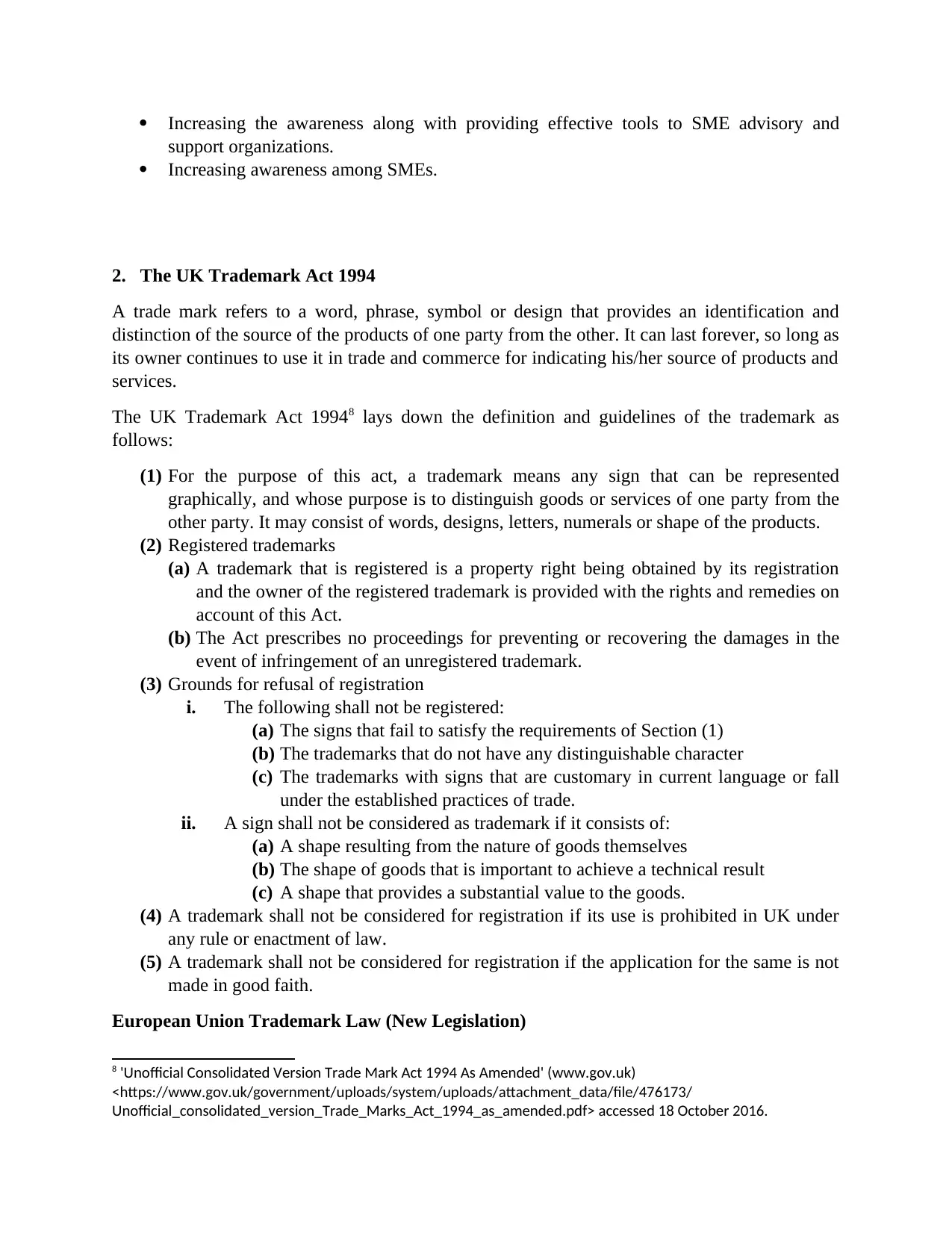
Increasing the awareness along with providing effective tools to SME advisory and
support organizations.
Increasing awareness among SMEs.
2. The UK Trademark Act 1994
A trade mark refers to a word, phrase, symbol or design that provides an identification and
distinction of the source of the products of one party from the other. It can last forever, so long as
its owner continues to use it in trade and commerce for indicating his/her source of products and
services.
The UK Trademark Act 19948 lays down the definition and guidelines of the trademark as
follows:
(1) For the purpose of this act, a trademark means any sign that can be represented
graphically, and whose purpose is to distinguish goods or services of one party from the
other party. It may consist of words, designs, letters, numerals or shape of the products.
(2) Registered trademarks
(a) A trademark that is registered is a property right being obtained by its registration
and the owner of the registered trademark is provided with the rights and remedies on
account of this Act.
(b) The Act prescribes no proceedings for preventing or recovering the damages in the
event of infringement of an unregistered trademark.
(3) Grounds for refusal of registration
i. The following shall not be registered:
(a) The signs that fail to satisfy the requirements of Section (1)
(b) The trademarks that do not have any distinguishable character
(c) The trademarks with signs that are customary in current language or fall
under the established practices of trade.
ii. A sign shall not be considered as trademark if it consists of:
(a) A shape resulting from the nature of goods themselves
(b) The shape of goods that is important to achieve a technical result
(c) A shape that provides a substantial value to the goods.
(4) A trademark shall not be considered for registration if its use is prohibited in UK under
any rule or enactment of law.
(5) A trademark shall not be considered for registration if the application for the same is not
made in good faith.
European Union Trademark Law (New Legislation)
8 'Unofficial Consolidated Version Trade Mark Act 1994 As Amended' (www.gov.uk)
<https://www.gov.uk/government/uploads/system/uploads/attachment_data/file/476173/
Unofficial_consolidated_version_Trade_Marks_Act_1994_as_amended.pdf> accessed 18 October 2016.
support organizations.
Increasing awareness among SMEs.
2. The UK Trademark Act 1994
A trade mark refers to a word, phrase, symbol or design that provides an identification and
distinction of the source of the products of one party from the other. It can last forever, so long as
its owner continues to use it in trade and commerce for indicating his/her source of products and
services.
The UK Trademark Act 19948 lays down the definition and guidelines of the trademark as
follows:
(1) For the purpose of this act, a trademark means any sign that can be represented
graphically, and whose purpose is to distinguish goods or services of one party from the
other party. It may consist of words, designs, letters, numerals or shape of the products.
(2) Registered trademarks
(a) A trademark that is registered is a property right being obtained by its registration
and the owner of the registered trademark is provided with the rights and remedies on
account of this Act.
(b) The Act prescribes no proceedings for preventing or recovering the damages in the
event of infringement of an unregistered trademark.
(3) Grounds for refusal of registration
i. The following shall not be registered:
(a) The signs that fail to satisfy the requirements of Section (1)
(b) The trademarks that do not have any distinguishable character
(c) The trademarks with signs that are customary in current language or fall
under the established practices of trade.
ii. A sign shall not be considered as trademark if it consists of:
(a) A shape resulting from the nature of goods themselves
(b) The shape of goods that is important to achieve a technical result
(c) A shape that provides a substantial value to the goods.
(4) A trademark shall not be considered for registration if its use is prohibited in UK under
any rule or enactment of law.
(5) A trademark shall not be considered for registration if the application for the same is not
made in good faith.
European Union Trademark Law (New Legislation)
8 'Unofficial Consolidated Version Trade Mark Act 1994 As Amended' (www.gov.uk)
<https://www.gov.uk/government/uploads/system/uploads/attachment_data/file/476173/
Unofficial_consolidated_version_Trade_Marks_Act_1994_as_amended.pdf> accessed 18 October 2016.

The European Parliament recently has officially adopted the EU trademark reform legislation. Its
purpose is to make trademark registration systems in EU cheaper, quicker, reliable and
predictable. The system of trademark registration was incorporated in EU member countries
more than 20 years ago. The national and Community Trademark (CTM) have been
harmoniously co-existing since 1996. It was in 2008 when European Commission conducted a
study on the part of Max Plank Institute with a purpose of evaluating the overall functioning of
CTM as well as national trademark systems. This step of the Commission resulted into various
draft amendments to the Trademarks Directive (2008/95/EC) and the CTM Regulation
(207/2009/EC).
The new European Union Trade Mark (EUTM) Regulation came into existence in March 2016
along with that a new trade Mark Directive was established in January 2016. The member
countries were required to implement the directive into their national laws. The exceptions were
being made with regards to administrative invalidation and revocation procedures.
The proposed changes in the existing Trademark Laws of European Union9 are as follows:
1) The CTM will be turned into EUTM and the Office for Harmonization in Internal Market
(OHIM) will be turned into European Union Property Office (EUIPO).
2) From 1st October 2017, it will not be necessary for the trademarks to be represented
graphically if they are clear and precise. It essentially establishes the fact that marks can
also be represented in different manner.
3) The products or goods that are being transferred through EU could be seized if they
appear to be infringing the EU trademark rights. Even in the situation when these
products are not meant for the consumers for EU.
4) There will be a provision for protecting intervening rights because it will ensure to
prevent the use of later trademark, if at the timing of filing date, the previous mark could
have been revoked for no use.
5) The “own name” protection shall be restricted to natural persons and using company
name will be identified as an infringing act.
6) Use of trademark in competitive advertising shall be considered as an infringing act
unless it fulfills the criteria of Competitive Advertising Directive (2006/114/EC).
7) Distribution and sales of labels and packaging could subsequently be incorporated with
infringing products.
8) Administrative proceedings in intellectual property offices will be deemed mandatory.
9) The class heading terms will only cover the literal meaning of the words regardless of the
filling date of the application.
10) Provision of new fee structure for EUTM applications.
International Trademark Law Treaty (TLT)10
9 Audrey Horton, 'EU Trade Mark Law: New Legislation Published' (Bird & Bird, 2016)
<http://www.twobirds.com/en/news/articles/2016/uk/ip-and-it-bytes-jan-feb/eu-trade-mark-law-new-legislation-
published> accessed 18 October 2016.
purpose is to make trademark registration systems in EU cheaper, quicker, reliable and
predictable. The system of trademark registration was incorporated in EU member countries
more than 20 years ago. The national and Community Trademark (CTM) have been
harmoniously co-existing since 1996. It was in 2008 when European Commission conducted a
study on the part of Max Plank Institute with a purpose of evaluating the overall functioning of
CTM as well as national trademark systems. This step of the Commission resulted into various
draft amendments to the Trademarks Directive (2008/95/EC) and the CTM Regulation
(207/2009/EC).
The new European Union Trade Mark (EUTM) Regulation came into existence in March 2016
along with that a new trade Mark Directive was established in January 2016. The member
countries were required to implement the directive into their national laws. The exceptions were
being made with regards to administrative invalidation and revocation procedures.
The proposed changes in the existing Trademark Laws of European Union9 are as follows:
1) The CTM will be turned into EUTM and the Office for Harmonization in Internal Market
(OHIM) will be turned into European Union Property Office (EUIPO).
2) From 1st October 2017, it will not be necessary for the trademarks to be represented
graphically if they are clear and precise. It essentially establishes the fact that marks can
also be represented in different manner.
3) The products or goods that are being transferred through EU could be seized if they
appear to be infringing the EU trademark rights. Even in the situation when these
products are not meant for the consumers for EU.
4) There will be a provision for protecting intervening rights because it will ensure to
prevent the use of later trademark, if at the timing of filing date, the previous mark could
have been revoked for no use.
5) The “own name” protection shall be restricted to natural persons and using company
name will be identified as an infringing act.
6) Use of trademark in competitive advertising shall be considered as an infringing act
unless it fulfills the criteria of Competitive Advertising Directive (2006/114/EC).
7) Distribution and sales of labels and packaging could subsequently be incorporated with
infringing products.
8) Administrative proceedings in intellectual property offices will be deemed mandatory.
9) The class heading terms will only cover the literal meaning of the words regardless of the
filling date of the application.
10) Provision of new fee structure for EUTM applications.
International Trademark Law Treaty (TLT)10
9 Audrey Horton, 'EU Trade Mark Law: New Legislation Published' (Bird & Bird, 2016)
<http://www.twobirds.com/en/news/articles/2016/uk/ip-and-it-bytes-jan-feb/eu-trade-mark-law-new-legislation-
published> accessed 18 October 2016.
⊘ This is a preview!⊘
Do you want full access?
Subscribe today to unlock all pages.

Trusted by 1+ million students worldwide
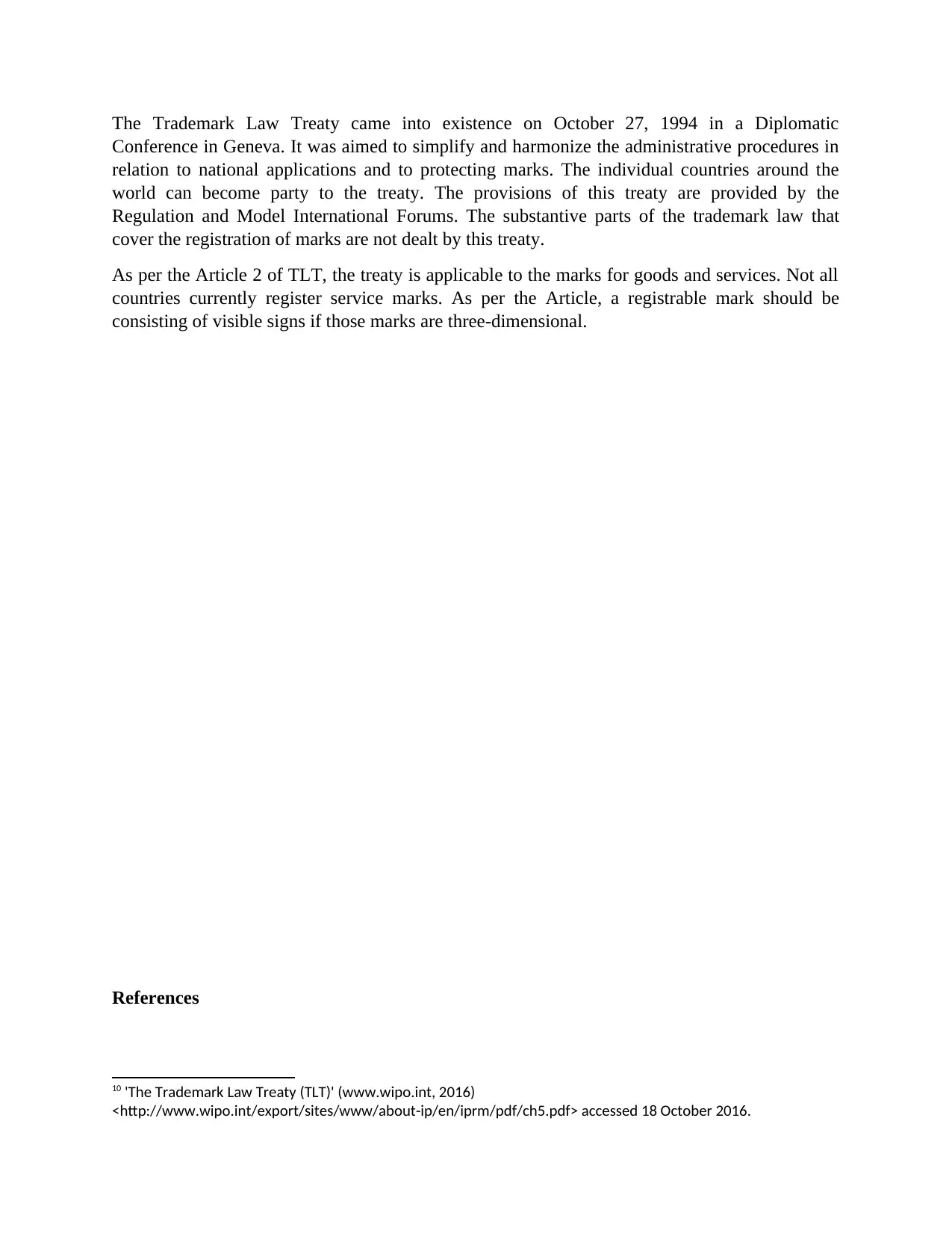
The Trademark Law Treaty came into existence on October 27, 1994 in a Diplomatic
Conference in Geneva. It was aimed to simplify and harmonize the administrative procedures in
relation to national applications and to protecting marks. The individual countries around the
world can become party to the treaty. The provisions of this treaty are provided by the
Regulation and Model International Forums. The substantive parts of the trademark law that
cover the registration of marks are not dealt by this treaty.
As per the Article 2 of TLT, the treaty is applicable to the marks for goods and services. Not all
countries currently register service marks. As per the Article, a registrable mark should be
consisting of visible signs if those marks are three-dimensional.
References
10 'The Trademark Law Treaty (TLT)' (www.wipo.int, 2016)
<http://www.wipo.int/export/sites/www/about-ip/en/iprm/pdf/ch5.pdf> accessed 18 October 2016.
Conference in Geneva. It was aimed to simplify and harmonize the administrative procedures in
relation to national applications and to protecting marks. The individual countries around the
world can become party to the treaty. The provisions of this treaty are provided by the
Regulation and Model International Forums. The substantive parts of the trademark law that
cover the registration of marks are not dealt by this treaty.
As per the Article 2 of TLT, the treaty is applicable to the marks for goods and services. Not all
countries currently register service marks. As per the Article, a registrable mark should be
consisting of visible signs if those marks are three-dimensional.
References
10 'The Trademark Law Treaty (TLT)' (www.wipo.int, 2016)
<http://www.wipo.int/export/sites/www/about-ip/en/iprm/pdf/ch5.pdf> accessed 18 October 2016.
Paraphrase This Document
Need a fresh take? Get an instant paraphrase of this document with our AI Paraphraser
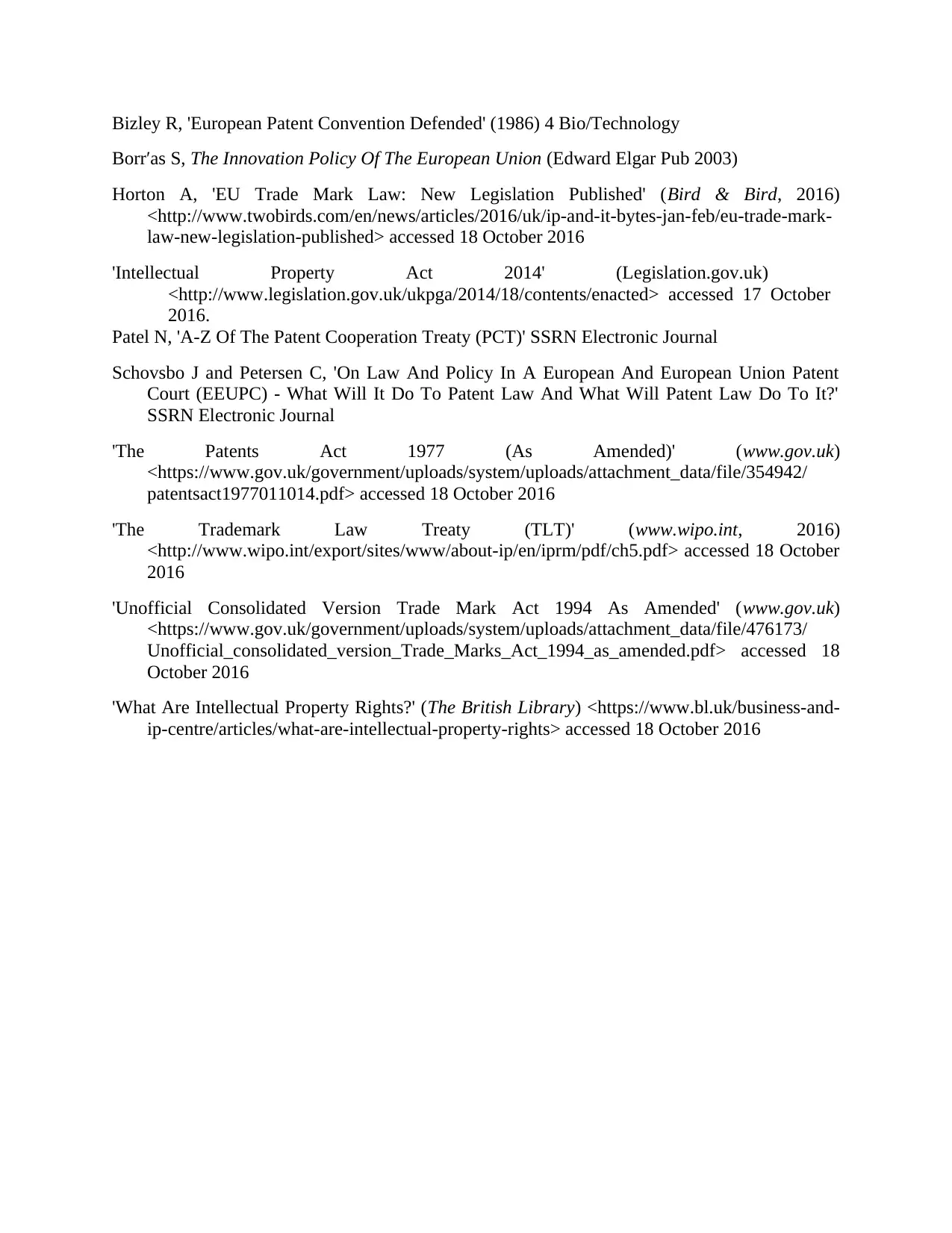
Bizley R, 'European Patent Convention Defended' (1986) 4 Bio/Technology
Borrʹas S, The Innovation Policy Of The European Union (Edward Elgar Pub 2003)
Horton A, 'EU Trade Mark Law: New Legislation Published' (Bird & Bird, 2016)
<http://www.twobirds.com/en/news/articles/2016/uk/ip-and-it-bytes-jan-feb/eu-trade-mark-
law-new-legislation-published> accessed 18 October 2016
'Intellectual Property Act 2014' (Legislation.gov.uk)
<http://www.legislation.gov.uk/ukpga/2014/18/contents/enacted> accessed 17 October
2016.
Patel N, 'A-Z Of The Patent Cooperation Treaty (PCT)' SSRN Electronic Journal
Schovsbo J and Petersen C, 'On Law And Policy In A European And European Union Patent
Court (EEUPC) - What Will It Do To Patent Law And What Will Patent Law Do To It?'
SSRN Electronic Journal
'The Patents Act 1977 (As Amended)' (www.gov.uk)
<https://www.gov.uk/government/uploads/system/uploads/attachment_data/file/354942/
patentsact1977011014.pdf> accessed 18 October 2016
'The Trademark Law Treaty (TLT)' (www.wipo.int, 2016)
<http://www.wipo.int/export/sites/www/about-ip/en/iprm/pdf/ch5.pdf> accessed 18 October
2016
'Unofficial Consolidated Version Trade Mark Act 1994 As Amended' (www.gov.uk)
<https://www.gov.uk/government/uploads/system/uploads/attachment_data/file/476173/
Unofficial_consolidated_version_Trade_Marks_Act_1994_as_amended.pdf> accessed 18
October 2016
'What Are Intellectual Property Rights?' (The British Library) <https://www.bl.uk/business-and-
ip-centre/articles/what-are-intellectual-property-rights> accessed 18 October 2016
Borrʹas S, The Innovation Policy Of The European Union (Edward Elgar Pub 2003)
Horton A, 'EU Trade Mark Law: New Legislation Published' (Bird & Bird, 2016)
<http://www.twobirds.com/en/news/articles/2016/uk/ip-and-it-bytes-jan-feb/eu-trade-mark-
law-new-legislation-published> accessed 18 October 2016
'Intellectual Property Act 2014' (Legislation.gov.uk)
<http://www.legislation.gov.uk/ukpga/2014/18/contents/enacted> accessed 17 October
2016.
Patel N, 'A-Z Of The Patent Cooperation Treaty (PCT)' SSRN Electronic Journal
Schovsbo J and Petersen C, 'On Law And Policy In A European And European Union Patent
Court (EEUPC) - What Will It Do To Patent Law And What Will Patent Law Do To It?'
SSRN Electronic Journal
'The Patents Act 1977 (As Amended)' (www.gov.uk)
<https://www.gov.uk/government/uploads/system/uploads/attachment_data/file/354942/
patentsact1977011014.pdf> accessed 18 October 2016
'The Trademark Law Treaty (TLT)' (www.wipo.int, 2016)
<http://www.wipo.int/export/sites/www/about-ip/en/iprm/pdf/ch5.pdf> accessed 18 October
2016
'Unofficial Consolidated Version Trade Mark Act 1994 As Amended' (www.gov.uk)
<https://www.gov.uk/government/uploads/system/uploads/attachment_data/file/476173/
Unofficial_consolidated_version_Trade_Marks_Act_1994_as_amended.pdf> accessed 18
October 2016
'What Are Intellectual Property Rights?' (The British Library) <https://www.bl.uk/business-and-
ip-centre/articles/what-are-intellectual-property-rights> accessed 18 October 2016
1 out of 8
Related Documents
Your All-in-One AI-Powered Toolkit for Academic Success.
+13062052269
info@desklib.com
Available 24*7 on WhatsApp / Email
![[object Object]](/_next/static/media/star-bottom.7253800d.svg)
Unlock your academic potential
Copyright © 2020–2025 A2Z Services. All Rights Reserved. Developed and managed by ZUCOL.




